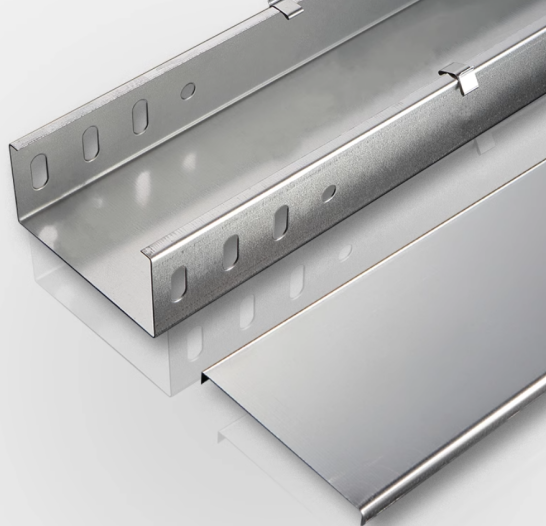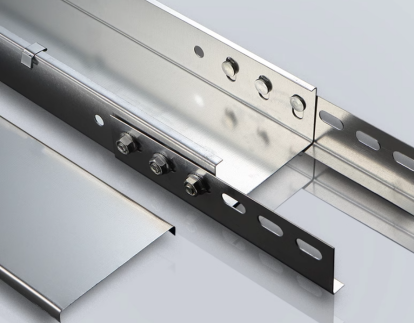When it comes to electrical installations, choosing the right cable management system is crucial for ensuring efficiency, safety, and durability. Two of the most common systems used are cable trays and metal trunking. While they may seem similar at first glance, they serve distinct purposes and have different specifications. This blog will explore the key differences between cable trays and metal trunking to help you make an informed decision for your installation project.
1. Definition and Purpose
Cable trays and metal trunking differ significantly in their primary use. Cable trays are designed to support and manage the installation of cables, typically for larger-scale projects like industrial or commercial buildings. They offer an open structure that allows for easier maintenance and flexibility in cable arrangements.
On the other hand, metal trunking is primarily used for smaller electrical wiring systems. It is typically a closed system, used to protect and organize wires rather than heavy-duty cables. Metal trunking is often seen in commercial or residential buildings where wiring is less extensive.
2. Size and Width Differences
A clear distinction between the two systems is their size. Cable trays are generally wider, with widths greater than 200mm, making them suitable for large volumes of cables. Metal trunking, in contrast, is usually narrower, with widths below 200mm, and is ideal for smaller installations such as wires that require protection in limited spaces.
3. Types and Structures
Cable trays come in various types, including ladder type, trough type, pallet type, and combined type. These different designs allow for greater flexibility in terms of installation and can handle a wide variety of cables. The material choices for cable trays include aluminum alloy, fiberglass, cold-rolled steel, and galvanized or spray-coated steel, offering different levels of corrosion resistance.
In comparison, metal trunking generally comes in a single form—typically made from hot-rolled steel. It is designed to be closed, offering better protection against external elements but less flexibility in cable management compared to the more open structure of cable trays.
4. Material and Corrosion Resistance
Cable trays are often installed in harsher environments, including outdoor settings, and need to withstand the elements. Therefore, they undergo various anti-corrosion treatments like galvanizing, plastic spraying, or a combination of both to ensure longevity and reliability.
Metal trunking, however, is mostly used indoors and is generally only made from galvanized iron or hot-rolled steel, which provides sufficient protection in less demanding environments.
5. Load Capacity and Support Considerations
When installing a cable tray system, important factors like load, deflection, and filling rate must be considered, as these systems often carry heavy, large-volume cables. Cable trays are designed to handle significant loads, making them suitable for larger installations.
In contrast, metal trunking is designed for smaller-scale installations and cannot support the same heavy loads. Its primary function is to protect and organize wires, not to bear heavy cable weights.
6. Open vs. Closed Systems
Another key difference is the openness of the systems. Cable trays are generally open, allowing for better airflow, which helps dissipate heat generated by the cables. This open design also allows for easier access during maintenance or when modifications are needed.
Metal trunking, however, is a closed system, providing more protection to the wires inside but limiting airflow. This design is advantageous for protecting wires from dust, moisture, or physical damage but may not be suitable for installations requiring frequent modifications or upgrades.
7. Carrying Capacity
The carrying capacity of the two systems also differs significantly. Due to its structural design, a cable tray can support larger cable bundles over longer distances. Metal trunking, being narrower and less robust, is more suited for small-scale electrical systems and wiring that do not require heavy support.
8. Installation and Appearance
Lastly, installation methods and overall appearance vary between the two. Cable trays, made of thicker materials, are generally installed more firmly and provide a sturdier solution for heavy cables. Their open structure also contributes to a more industrial look, which may be preferred in certain environments like factories or power plants.
Metal trunking has a more streamlined appearance due to its closed nature and is typically made from thinner materials like galvanized iron sheets. This makes it easier to install in more constrained spaces and allows for a neater appearance in settings where aesthetics are important.
Conclusion
In summary, both cable trays and metal trunking have their own specific uses and advantages depending on the type of installation required. Cable trays are ideal for larger projects that require robust support and flexibility, while metal trunking is better suited for smaller, more confined electrical systems. Understanding the differences between these systems ensures that you choose the right solution for your project’s needs, whether it’s an industrial site, a commercial building, or a residential installation.
By considering factors such as load capacity, material, size, and installation environment, you can make a well-informed decision about which cable management system best fits your specific requirements.
Meta Title: Difference Between Cable Tray and Metal Trunking: A Comprehensive Guide
Meta Description: Learn the key differences between cable trays and metal trunking, from materials and structure to applications. Find out which is best for your cable management needs.
Post time: Oct-10-2024








